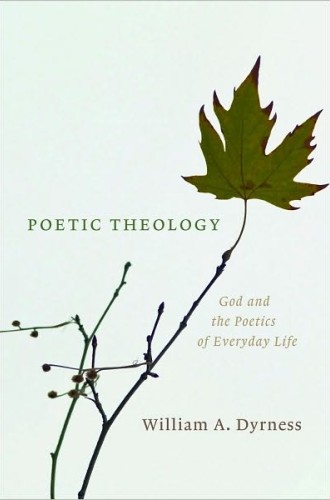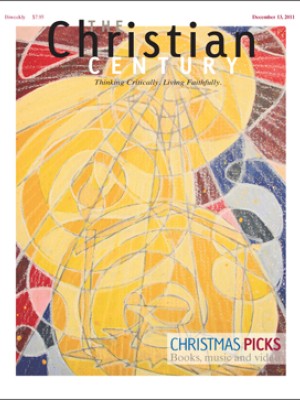Poetic Theology, by William A. Dyrness
In Poetic Theology, William Dyrness tries to keep one eye on the historical conversation about art's theological value, one eye on the issues of the contemporary church, and one eye on the interests of art itself. As the metaphor implies, this project could make anyone dizzy. But disorientation, "making strange," is central to the artfulness of poetry, and it is this artfulness that Dyrness wants to restore to Protestant Christian practice. "This book seeks to connect poetry and theology. It probably ought to have been written in poetry," his preface begins.
Indeed, perhaps only a poem could achieve the synthesis of theology and lived experience to which Dyrness is admirably drawn. This book bears little resemblance to a poem. Poetic Theology teaches and recapitulates, at times masterfully, but does not reorient or discomfit in the way good art does. In its own shape and style, Dyrness's book demonstrates the gulf between poetry and theology in our current discourse.
Read our latest issue or browse back issues.
Eager to accommodate upper-middle-class American life, Dyrness takes as his starting point the secular passions of young people. He wants a theology that has room for "creative activities of many kinds," including watching college football, skiing, visiting art galleries, even playing video games. This apologetic approach allows Dyrness to frame theological questions in ways that directly apply to the local church: Where do the "passionate commitments" of contemporary secular people to "build, move, create" come from? As Christians, how do we fit these extra-ecclesial, nonreligious passions into the gospel's call? And, most importantly for Dyrness, how should the church change to reflect—and attract—a society driven by these concerns and expectations?
Seeking answers to these questions, Poetic Theology starts with a 200-page tour through Christian aesthetic thought. Major stops include Augustine, the medievals (Dante and Pico), the Pietists (Schiller, Kant), artistic Calvinists (Edwards and Kuyper) and contemporary figures like Hans Urs von Balthasar and Graham Ward. There are good explanations of art in every Christian age, and as Dyrness shows, both romantic and modernist artists are indebted to Christianity for their sense of poetry's powers. Throughout this survey, Dyrness's sympathies lie with the thinkers who defend human desire and praise our ability to relate to God through our senses. Dyrness rightly insists, however, that we must ground human desire and imagination in scripture and in God's own trinitarian relationship. Art can indeed give praise to God, but it matters how and why we praise.
The sixth and seventh chapters, in which Dyrness specifically explores his own Reformed Protestantism's uneasy relationship to art, are the best part of the book. Through a reading of John Bunyan, the Puritans and Dutch painting, Dyrness comes close to formulating a theological poetics. Rather than presuming that one can arrive at a complete knowledge of God in human life, Reformed theology shapes itself according to the story of our salvation through Jesus Christ. It is this drama of estrangement and redemption, and not God Godself, that art can animate. In contrast to Dante's Comedy, where life is a journey toward an unmediated vision of the divine, a Protestant poetics is indirect, auditory, dialectical, quotidian. Or to cite Emily Dickinson: "Tell all the Truth but tell it slant."
Knowledgeable and proud of this slanted approach, Dyrness demonstrates Reformed Protestantism's capacity to inspire lasting art. But he also has a bone to pick with his tradition, particularly the way many Protestants have been led to regard aesthetic experience with suspicion or ignorance. What Calvin said about images, music, dancing and ceremonies in 16th-century Switzerland only goes so far. Furthermore, as Dyrness shows, the general intention and temperament of Calvin's Institutes actually encourages us to explore faith's aesthetic aspect.
Responding to the larger secular culture, with its wedding industry and Yelp reviews and MFA programs, Poetic Theology presents a church that is open to the different ways the Spirit can work. The book's most controversial and courageous moment is when Dyrness insists that any theology of justice is incomplete without aesthetic elucidation. As in both Isaiah and Revelation, social transformation originates in the imagination. Beauty is no afterthought to God. Dyrness's striking proposal that "we need a fresh vision of God apart from and before we work for justice" should resonate prophetically with liberal and conservative Christians alike.
Dyrness concludes by calling Protestant churches back to a greater appreciation of style and form in worship. His intimacy with Reformed thought allows him to present his own reforming project in faithful and appealing terms: "Calvin sought to purify the heart precisely by removing distracting images. But in so doing, he inadvertently discouraged the shaping of objects that stimulate the imagination and fire the heart, thus diminishing the very inner life he meant to celebrate." We must start trusting our eyes and our feelings again in order to more fully trust God.
So what does this creative trust look like? Dante clearly shapes Dyrness's high opinion of human creativity in all its strangeness. But what about modernists like Wallace Stevens, whose "Sunday Morning" anticipates Dyrness's assessment of our aesthetically evaluative culture by almost a hundred years. And what about contemporary poets who are still specifically engaged with Reformed thought, like Donald Revell and Pam Rehm?
In Dyrness's call for a constructive Protestant poetic theology, one misses the presence of actual poetry. Although its survey of Christian aesthetics is rich, Poetic Theology may end up reaffirming the very divide between art and church that it laments.






